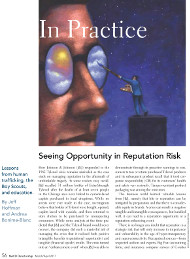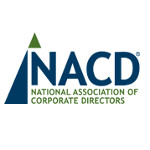Download: “Seeing Opportunity in Reputation Risk”
 The National Association of Corporate Directors’ new article, “Seeing Opportunity in Reputation Risk,” explores how effective board oversight of corporate responsibility (CR) and environmental, social, and governance (ESG) strategies, practices, risk management, and crisis preparedness can not only help manage strategic risk, but also result in enhanced reputation.
The National Association of Corporate Directors’ new article, “Seeing Opportunity in Reputation Risk,” explores how effective board oversight of corporate responsibility (CR) and environmental, social, and governance (ESG) strategies, practices, risk management, and crisis preparedness can not only help manage strategic risk, but also result in enhanced reputation.
The article can be downloaded from the NACD site at no charge.
The following is an excerpt from this article by Jeff Hoffman and Andrea Bonime-Blanc, which appears in the March/April issue of NACD Directorship magazine:
“ESG and CR are frequently not on boards’ radar. When they are, there is rarely sufficient time allocated to their discussion. There are reputation risks and value creation opportunities that can be found beyond what is normally discussed at board meetings. Unfortunately, many ESG and CR risks are unknown to the board until an incident happens and it goes public—and possibly viral. The risks around ESG and CR are generally easy to identify, mitigate, and plan around. While being prepared for the worst-case scenario may take time and effort, it will be far less painful than the alternative: negative headlines and conversations on social media.”
 The announcement by the Department of Justice Fraud Section that it hired Hui Chen, a lawyer with previous experience as a federal prosecutor and international corporate compliance, as a full-time Foreign Corrupt Practices Act compliance expert shows that compliance should be high on corporate agendas for 2016., writes
The announcement by the Department of Justice Fraud Section that it hired Hui Chen, a lawyer with previous experience as a federal prosecutor and international corporate compliance, as a full-time Foreign Corrupt Practices Act compliance expert shows that compliance should be high on corporate agendas for 2016., writes  The National Association of Corporate Directors (NACD) recently released the 2015-2016 NACD Public Company Governance Survey, which compiles benchmarking data on governance trends and practices from more than 1,000 public company governance corporate directors and governance professionals. A few of the key findings from this year’s survey include:
The National Association of Corporate Directors (NACD) recently released the 2015-2016 NACD Public Company Governance Survey, which compiles benchmarking data on governance trends and practices from more than 1,000 public company governance corporate directors and governance professionals. A few of the key findings from this year’s survey include: The pursuit of legitimate corporate strategic goals is increasingly running into the concerns of corporate officers who see themselves at greater personal legal risk if there are ever allegations of corporate misconduct, writes
The pursuit of legitimate corporate strategic goals is increasingly running into the concerns of corporate officers who see themselves at greater personal legal risk if there are ever allegations of corporate misconduct, writes